A) longer than today
B) same length as today
C) half as long as today
D) it did not yet exist
Correct Answer

verified
Correct Answer
verified
Multiple Choice
Which of these numbers is on the abyssal plane? 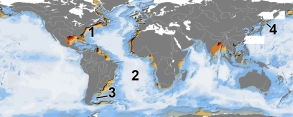
A) 1
B) 2
C) 3
D) 4
E) none of these
Correct Answer

verified
Correct Answer
verified
Multiple Choice
How wide was the narrow ocean between the central and eastern continents 20 million years ago? 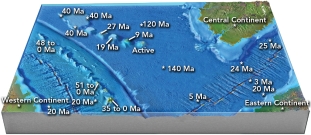
A) wider than it is today
B) same width as it is today
C) a little narrower than it is today
D) it was much narrower
Correct Answer

verified
Correct Answer
verified
Multiple Choice
The abrupt change from thinned, faulted continental crust to oceanic crust occurs at the:
A) continental slope
B) continental shelf
C) continental rise
D) abyssal plain
Correct Answer

verified
Correct Answer
verified
Multiple Choice
Which of the following seas currently has back-arc spreading?
A) Sea of Japan
B) Baltic Sea
C) Bering Sea
D) Gulf of California
E) all of these
Correct Answer

verified
Correct Answer
verified
Multiple Choice
What information can be determined directly by analyzing drill cores?
A) The type of sediment on the seafloor
B) The rate of sediment deposition
C) The type of rock on the seafloor
D) All of these
Correct Answer

verified
Correct Answer
verified
Multiple Choice
Where was the oceanic plateau relative to the hot spot 20 million years ago? 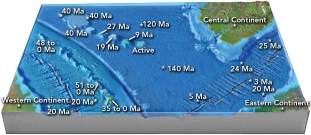
A) farther away than today
B) the same distance as today
C) half the distance as today
D) on top of the hot spot
Correct Answer

verified
Correct Answer
verified
Multiple Choice
Hot spots form linear island chains because:
A) the plate moves relative to the underlying hot spot
B) they are aligned with trenches formed by subduction
C) they occur along the mid-oceanic ridges
Correct Answer

verified
Correct Answer
verified
Multiple Choice
In the ocean Investigation in the textbook, which processes) probably formed islands?
A) volcanism associated with a hot spot
B) volcanism associated with a mid-ocean ridge
C) fragmentation of continents by long transform faults
D) back-arc spreading
E) all of these
Correct Answer

verified
Correct Answer
verified
Multiple Choice
Which of the following is a consistent feature of reefs and atolls?
A) volcanic islands
B) passive continental margins
C) divergent plate boundaries
D) carbonate rocks and accumulations
Correct Answer

verified
Correct Answer
verified
Multiple Choice
Which of the following is NOT a way in which we map and investigate the seafloor?
A) bouncing sound waves from a ship off the bottom
B) drilling holes into the seafloor from ships
C) using satellites to observe the sea surface
D) conducting seismic surveys to investigate rock layers
E) we use all of these techniques
Correct Answer

verified
Correct Answer
verified
Multiple Choice
What is the origin of the volcanoes in the Lesser Antilles and Central America?
A) two hot spots on either side of the Caribbean plate
B) subduction of oceanic crust beneath the Caribbean plate
C) magma leaking up along transform faults
D) rapid spreading along the Mid-Atlantic Ridge
Correct Answer

verified
Correct Answer
verified
Multiple Choice
Which of the following seas) was formed when subduction jumped or shifted outward from the continent?
A) North Sea
B) Bering Sea
C) Philippine Sea
D) Gulf of California
E) all of these
Correct Answer

verified
Correct Answer
verified
Multiple Choice
These globes show the position of the continents and ocean basins at various times in the past. Which of these represents the oldest time? 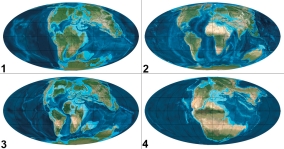
A) 1
B) 2
C) 3
D) 4
Correct Answer

verified
Correct Answer
verified
Multiple Choice
Which of the following seas was formed by loading of thrust sheets of the Zagros Mountains?
A) North Sea
B) Red Sea
C) Persian Gulf
D) Baltic Sea
E) all of these
Correct Answer

verified
Correct Answer
verified
Multiple Choice
Which of these numbers is near a site with active seafloor spreading? 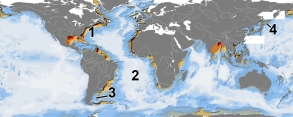
A) 1
B) 2
C) 3
D) 4
E) none of these
Correct Answer

verified
Correct Answer
verified
Multiple Choice
These globes show the position of the continents and ocean basins at various times in the past. What is the correct order of these globes, from oldest to youngest? 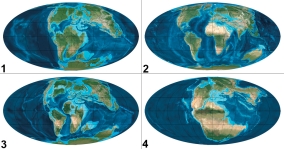
A) 1, 2, 3, 4
B) 1, 4, 3, 2
C) 4, 3, 2, 1
D) 4, 3, 1, 2
E) 4, 1, 3, 2
Correct Answer

verified
Correct Answer
verified
Multiple Choice
What do you think might happen to the oceanic plateau 20 million years into the future? 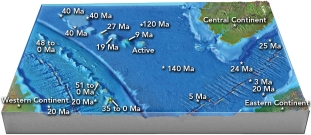
A) It may become much larger than it is today.
B) It may collide with and become part of the central continent.
C) It may subside and become part of the abyssal plain.
D) It may collide with the trench.
Correct Answer

verified
Correct Answer
verified
Multiple Choice
What are the characteristics of natural salt NaCl) deposits?
A) Deposited in layers
B) Very soluble in water
C) Can flow to form domes
D) All of these are characteristics of natural salt deposits
Correct Answer

verified
Correct Answer
verified
Multiple Choice
Which of these numbered features has the thinnest sediment? 
A) 1
B) 2
C) 3
D) 4
E) none of these
Correct Answer

verified
Correct Answer
verified
Showing 21 - 40 of 105
Related Exams